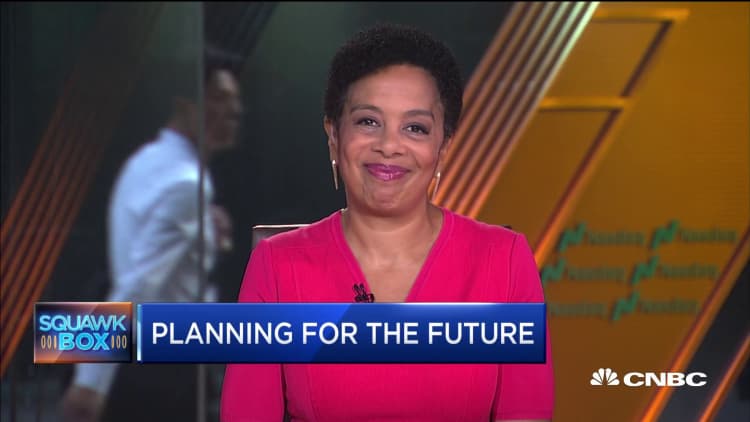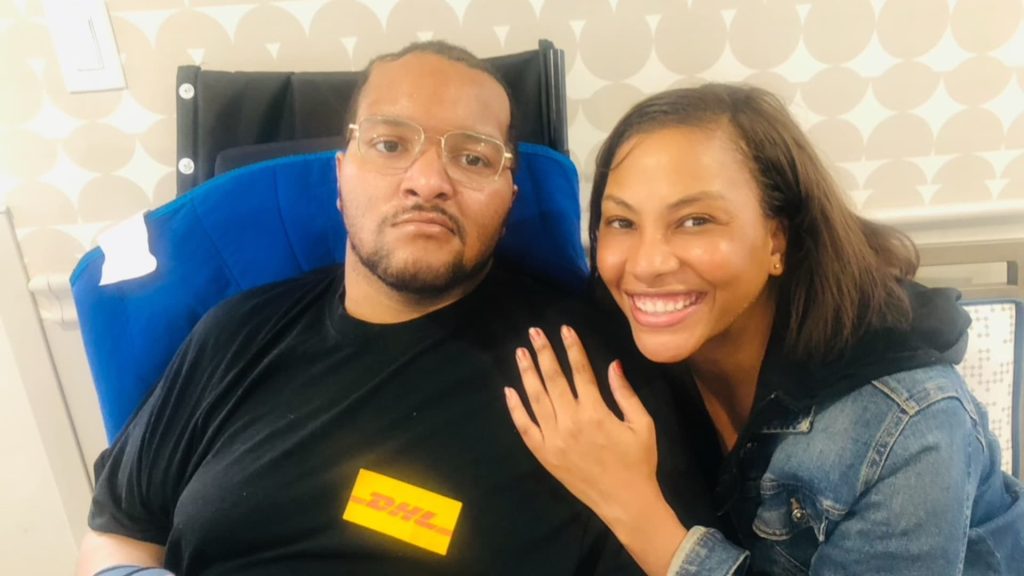A former line haul driver, Brandon Dickerson, 34, became disabled after a ruptured aneurysm caused bleeding in his brain. His sister, Geneva, is one of his caregivers.
Courtesy: Dickerson Family
Brandon Dickerson collapsed in his Louisiana home in March 2022, after suffering from a ruptured brain aneurysm. The sudden burst of a blood vessel caused bleeding in his brain. The former line haul driver went into a coma, and when he woke up, he had severe functional limitations.
“His cognitive skills and communication skills are limited,” Geneva Dickerson, Brandon’s older sister and caregiver, recently told CNBC. Brandon, now 34, lives in a traumatic brain injury nursing home in Queens, New York. “We are able to have limited conversation. He’s starting to say sentences now, which is great.”
Brandon’s improved speech gives Geneva hope. She is now looking into new benefits available for tax-advantaged savings accounts that may help cover therapy to support his progress.
Recent legislation, including President Donald Trump’s “big beautiful bill,” contains provisions that bolster the use of so-called Achieving a Better Life Experience, or ABLE, accounts. These tax-advantaged accounts are designed to help eligible individuals with disabilities save and invest money without jeopardizing their eligibility for certain government benefits, such as Medicaid, Social Security Disability Insurance, and Supplemental Security Income.
“ABLE accounts allow for savings and contributions from family and friends, serving as a supplement when other benefits are insufficient,” said Mary Morris, CEO of Commonwealth Savers, a Virginia-based organization that manages tax-advantaged 529 education savings and ABLE programs.
Here’s how ABLE accounts work, and what changes are in store.
How ABLE accounts work today
A federal law created the ABLE program in 2014.
Like 529 education savings plans, ABLE accounts are managed by states. Forty-six states and Washington, D.C., currently offer ABLE programs, and many state plans are open to outside residents. The Virginia-based plan ABLEnow, for example, is open to residents in every state.
Saving in these accounts will not adversely impact government benefits. Up to $100,000 of savings in an ABLE account is not counted toward the SSI resource limit. And any amount of ABLE savings up to the ABLE plan’s limit won’t count as a resource for other government benefits, including SSDI, Medicare, or Medicaid.
ABLE accounts grow tax-free with no federal or state income tax on withdrawals for qualifying expenses, as long as the funds are used for disability-related costs, including housing, transportation, and healthcare.
There are generally no income limits to contribute to an ABLE account for an eligible beneficiary.
However, the beneficiary must receive SSDI or SSI benefits, or have a physician’s statement that says the onset of the disability started before age 26.
More people can access ABLE accounts in 2026
Starting January 1, 2026, the ABLE Age Adjustment Act will increase age eligibility requirements from age 26 to 46, allowing millions more people to qualify.
About 8 million people currently qualify for ABLE accounts, with assets totaling about $2.5 billion, as of March 2025, according to Paul Curley, executive director at ISS Market Intelligence, a data provider for the financial services industry.
The number of assets and accounts is expected to increase by about 50% next year, he said, with an estimated 15 million people becoming eligible due to their age.
“This is a game changer,” said Charlie Massimo, a financial advisor and senior vice president at Wealth Enhancement Group in Long Island, New York. He is also the father of two 25-year-old sons with autism, and has ABLE accounts for both. “For the first time, millions of Americans with disabilities will have access to the same kind of tax-advantaged wealth-building accounts most families already have.”
Commonwealth Savers’ Morris said the wider age range “captures those young adults where a lot of debilitating illnesses really happen,” including multiple sclerosis, post-traumatic stress disorder, stroke, and certain neurological issues. Plus, at least one million more veterans could now qualify for an ABLE account, experts say.
‘Big beautiful bill’ changes for ABLE accounts
The “big beautiful” tax and spending package that Trump signed in early July will also make permanent several tax advantages from the Tax Cuts and Jobs Act that could help make ABLE accounts more attractive to savers.
The annual contribution limit for ABLE accounts is based on the annual gift tax exclusion, which is $19,000 per recipient in 2025 and will likely increase with inflation in future years, experts say.
A severely disabled worker may be able to contribute more than the annual limit if they or their employer is not making certain retirement plan contributions. The amount they can contribute is determined by the state that manages the plan and, in part, depends on their compensation.

Under the legislation’s terms, assets from a 529 college savings plan can be rolled over into an ABLE account.
“Let’s say you save for college for your son or daughter’s entire life, you have $100,000 or $200,000 in there, and now they have a disability later in life,” Massimo said. “Now you can really roll over the entire amount and then still put an additional $19,000 in for the annual gifting into an ABLE account.”
For low-income savers, contributors to an ABLE account may be eligible for the saver’s credit, a tax break typically available to those who save for retirement. Starting in 2027, the annual contribution eligible for the Saver’s Credit will increase from $2,000 to $2,100, with a maximum tax credit of $1,050.
Geneva Dickerson said she’ll look into the tax advantages of ABLE accounts, but she is now focused on building funds to open an ABLE account for Brandon, to provide her brother with the services he needs to progress.
“His insurance doesn’t cover speech therapy,” she said. “It’s out of the budget. But I think with an account like the ABLE account, he can use those funds to pay for more speech therapy or for more physical therapy if the insurance doesn’t cover it.”
SIGN UP: Money 101 is an 8-week learning course on financial freedom, delivered weekly to your inbox. Sign up here. It is also available in Spanish.

